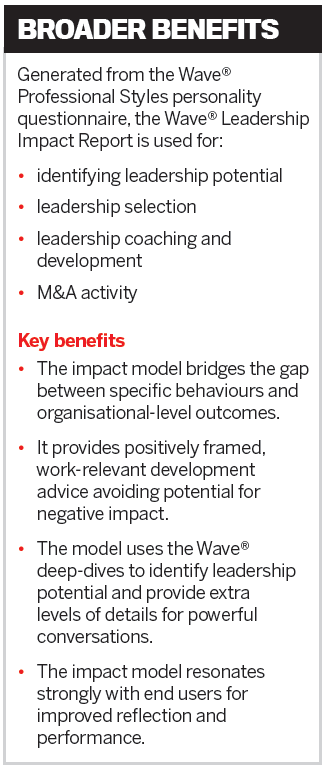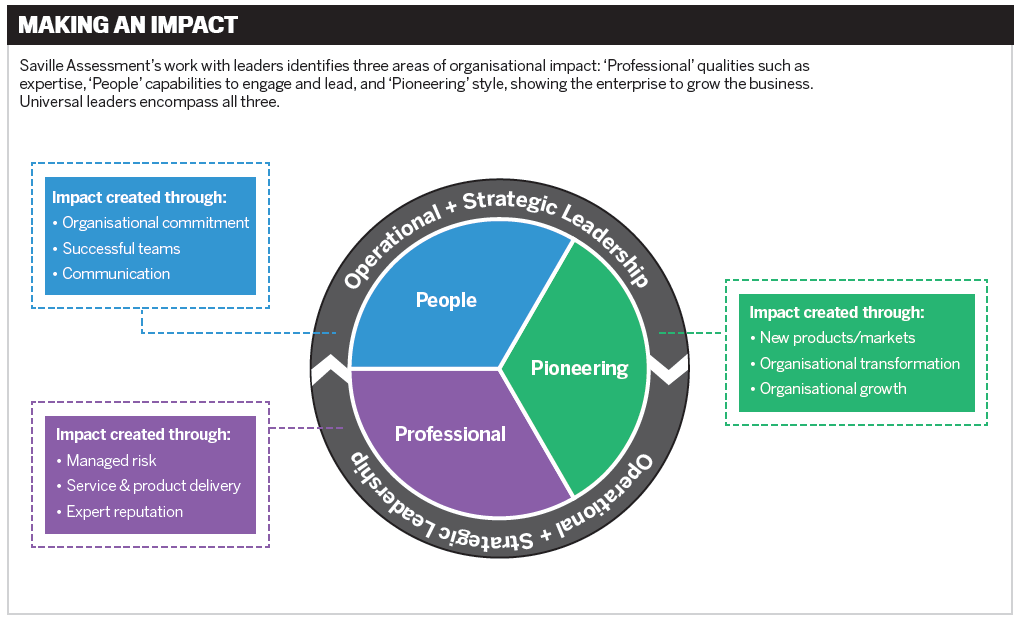An individual’s personality and behaviour traits can play a critical role in their success – or failure
.JPG)
Leaders must balance multiple priorities and countless disparate strategies, so it’s no surprise that an individual’s personality and behaviour traits can play a critical role in their success – or failure
In business, results matter, and organisational effectiveness is perhaps the ultimate measure of successful leadership. This means more than making financial returns for shareholders or achieving public service objectives; indeed, in order to sustainably deliver on those fronts, leaders need to be on top of a whole lot more – and it’s these other components that separate exceptional leaders from competent leaders.
For example, leaders must set an example for managing risk and protecting the reputation of the organisation. They must continually monitor quality of goods and services, while also identifying gaps in the market, cultivating innovation and managing change. Just as critically, they are required to foster successful teams and create a shared sense of purpose to engage employees and gain their commitment.
American author and management expert Kenneth Blanchard once stated: “The key to successful leadership today is influence, not authority.” It’s easy to see why he made this claim. While a leader of course has a job title to fall back on and also ideally possesses great technical skills, there are other, less tangible traits they should ideally hold.
“Leaders get things done through other people,” says Scott Ruhfus, managing director, Saville Assessment Asia Pacific. “That is going to involve a whole array of attributes which are essentially behavioural in nature.”
Ruhfus adds that it may come as a shock to some to realise that assertiveness is still one of those attributes. “You need a strong sense of purpose and direction to be a leader,” he says. “You have to make important decisions that will affect a lot of people, quickly and convincingly; and you will need to stand by them. You have to take charge of situations, control things, and give instructions to other people.”
Just as important, Ruhfus says, is how the leader goes about this. “Do you tell or sell? Are you able to empathise with the different needs and motivations of the individuals you lead? Are you fair and trustworthy?”
Even when times are tough, great leaders have the emotional intelligence and self-awareness to inspire people.
“People can be inspired in different ways,” Ruhfus says. “But effective leaders are able to motivate us. It may be because they communicate with enthusiasm and passion. Often they are good role models who practise what they preach. They remain calm under pressure or they create a compelling vision of the future. They use their understanding of people to make the right pitch and engage us.”
Right time, right place
A leader’s individual behavioural traits may ensure they excel in certain circumstances and situations.
“Differences in behavioural style will predispose leaders to be more effective in some situations than others,” Ruhfus says. “From the literature and our own research, we’ve identified 18 different leadership styles based on personality differences.”
“Leaders get things done through other people. That is going to involve a whole array of attributes which are essentially behavioural in nature” - Scott Ruhfus, Saville Assessment
A leader with a collaborative, empowering style will be very good at developing successful teams, for example. A leader with a creative, promotional style will be better at cultivating new products and disrupting markets. In all cases, however, strengths can be overplayed and cause leaders to derail, unless they are counterbalanced by compensating behaviours. For example, the disruptive leader may leave a legacy of uncertainty and non-compliance.
It’s also possible to have a leader/organisation mismatch. “This is directly related to the issue of situational leadership,” Ruhfus says. “Think of culture as the ‘personality’ of an organisation. If the leader’s personality is different to that of the organisation, there will be a clash. The style of the leader does not match the leadership situation.”
Where might situational leadership come into play? Examples might include situations in which:
- the long-term vision of an organisation needs to be developed
- a positive attitude helps to promote goals and achieve success
- it is important for people to innovate and challenge the ideas of others
- purposeful interaction with others is required to achieve a goal
- persuasion is required in order to overcome resistance to ideas or plans
- people require inspiration to help them define and achieve goals

Fortunately, today there are sophisticated profiling tools available to avoid mismatches, and to ensure that leaders themselves are aware of their behavioural style, including potential strengths and weaknesses.
Ruhfus says clients of Saville Assessment will typically approach the company to talk about their unique needs. The Saville team will look at their assessment criteria and advise on the best way to measure it.
“We often design systems for them, customise reporting, and train them to use the tools in a self-sufficient manner,” Ruhfus says.
Specifically, Saville uses a behavioural style questionnaire called Wave® and a 360-degree instrument, which look at the leadership style of the individual, the impact it makes on organisational effectiveness, and the leadership situations for which they are likely to be best suited. As many as 108 different aspects of personality are examined to help guide the individual on areas that can be developed and strengths they can leverage. The result is the Leadership Impact Report (see box, left).
Importantly, Saville’s Leadership Impact model helps organisations to bridge the gap between leaders’ styles and their impact on key leadership outcomes. The model switches focus from behavioural competencies to nine output-focused impact areas, clustered under the ‘3 P’s’: Professional, People and Pioneering (see first box). In summary:
- ‘Professional’ examines not just how meticulous and detailed an individual is but also what impact they create through managing risk, building expertise, and service delivery.
- ‘People’ includes an impact area called communication; however, this area is not only focused on a leader’s individual communication style but on whether that leader can ensure communication across the organisation is relevant and effective.
- ‘Pioneering’ is not solely concerned with how creative and innovative a leader is but whether this will have tangible outcomes with regard to developing new products or exploring new opportunities.
Attitude towards risk is a key part of any leadership role and is even more pertinent in certain roles and industries. Saville’s Leadership Risk Report can identify how potential leaders are likely to approach risk across nine critical aspects of leadership that sit under the 3 P’s. The reports come with practical insights, tips and recommendations that can be actioned promptly by the individual.
For those taking part in the Leadership Risk Report, implications are given for the two areas of highest potential risk, relating to the individual, the organisation and the culture.
The road ahead
Globally renowned business leader and investment icon Warren Buffett once stated: “In the business world, the rear-view mirror is always clearer than the windshield.” The road ahead is indeed uncertain, but in an age of predictive analytics, Saville’s assessment reports can also be used to predict the performance of upcoming leaders.
“Think of culture as the ‘personality’ of an organisation. If the leader’s personality is different to that of the organisation, there will be a clash” - Scott Ruhfus, Saville Assessment
Generated from the one well-respected questionnaire, Wave®, the Leadership Impact Report and the Leadership Risk Report provide normed scores against 18 Leadership Styles, 9 Organisational Impact areas, and 9 Potential Risk areas.
“The scores provide a valid indication of likely performance of current leaders as well as potential of future leaders,” Ruhfus says.
With statistics from Willis Towers Watson’s Global Talent Management and Rewards study indicating that just 39% of employees believe organisations are doing a ‘good’ or ‘very good’ job of developing future leaders, it might be time to re-examine not just the leadership development options on offer, but what leadership behaviours these future leaders demonstrate and in what circumstances they will excel.
SAVILLE ASSESSMENT ASIA PACIFIC
Saville Assessment Asia Pacific specialises in precision talent assessments that increase organisational and people performance. We take the time to understand your organisation and create specialist tailored solutions. We are dedicated to enabling HR to reach their goals through strategic people decisions based on data and analytics. P: (02) 9954 0840; E: [email protected] / www.savilleassessment.com.au
Scott will be facilitating a free workshop on recruitment and selection at the National HR Summit in Sydney, 2.15pm, 14 March 2018. For further information on Scott's workshop and the National HR Summit, click here









